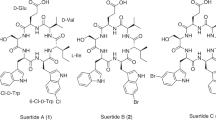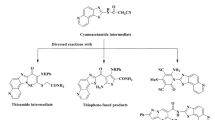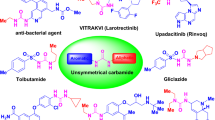Abstract
Cylindrol A5, a new ascochlorin congener, was isolated along with 14 known compounds from the culture broth of Cylindrocarpon sp. FKI-4602 by solvent extraction, octadecylsilane column chromatography and HPLC. The structure of cylindrol A5 was elucidated by spectral analyses, including NMR. The compound has an ascochlorin skeleton consisting of a resorcin aldehyde and a cyclohexanone moieties. Cylindrol A5 showed moderate antimicrobial activity against Bacillus subtilis, Kocuria rhizophila, Mycobacterium smegmatis and Acholeplasma laidlawii. The biosynthetic pathway to cylindrol A5 was deduced from the 14 isolated metabolites of the fungal strain.
Similar content being viewed by others
Log in or create a free account to read this content
Gain free access to this article, as well as selected content from this journal and more on nature.com
or
Accession codes
References
Keller, N. P., Turner, G. & Bennett, J. W. Fungal secondary metabolism - from biochemistry to genomics. Nat. Rev. Microbiol. 3, 937–947 (2005).
Hoffmeister, D. & Keller, N. P. Natural products of filamentous fungi: enzymes, genes, and their regulation. Nat. Prod. Rep. 24, 393–416 (2007).
Sanchez, J. F., Somoza, A. D., Keller, N. P. & Wang, C. C. Advances in Aspergillus secondary metabolite research in the post-genomic era. Nat. Prod. Rep. 29, 351–371 (2012).
Kawaguchi, M., Nonaka, K., Masuma, R. & Tomoda, H. New method for isolating antibiotic-producing fungi. J. Antibiot. 66, 17–21 (2013).
Dictionary of Natural Products on DVD December 2011, Chapman & Hall, CRC Press: London Version 20.2 (2011).
Takamatsu, S. et al. A novel testosterone 5α-reductase inhibitor, 8′,9′-dehydroascochlorin prooduced by Verticillium sp. FO-2787. Chem. Pharm. Bull. 42, 953–956 (1994).
Altschul, S. F. et al. Gapped BLAST and PSI-BLAST: a new generation of protein database search programs. Nucleic Acids Res. 25, 3389–3402 (1997).
von Arx, J. A. The Genera of Fungi Sporulating in Pure Culture 3rd edn 273 (Verlag J Cramer: Vaduz, 1981).
Ivanova, V., Backor, M., Dahse, H. M. & Graefe, U. Molecular structural studies of lichen substances with antimicrobial, antiproliferative, and cytotoxic effects from Parmelia subrudecta. Prep. Biochem. Biotechnol. 40, 377–388 (2010).
Sanchez, J. F. et al. Molecular genetic analysis of the orsellinic acid/F9775 gene cluster of Aspergillus nidulans. Mol. Biosyst. 6, 587–593 (2010).
Singh, S. B. et al. Chemistry and Biology of Cylindrols: Novel Inhibitors of Ras Farnesyl-Protein Transferase from Cylindrocarpon lucidum. J. Org. Chem. 61, 7727–7737 (1996).
Gutiérrez, M., Theoduloz, C., Rodríguez, J., Lolas, M. & Schmeda-Hirschmann, G. Bioactive metabolites from the fungus Nectria galligena, the main apple canker agent in Chile. J. Agric. Food Chem. 53, 7701–7708 (2005).
Knothe, G. & Kenar, J. Determination of the fatty acid profile by 1H-NMR spectroscopy. Eur. J. Lipid Sci. 106, 88–96 (2004).
Mori, K. & Fujioka, T. Synthesis of (±)-ascochlorin, (±)-ascofuranone and LL-Z1272. Tetrahedron 40, 2711–2720 (1984).
Seephonkai, P., Isaka, M. & Kittakoop, P. A novel ascochlorin glycoside from the insect pathogenic fungus Verticillium hemipterigenum BCC 2370. J. Antibiot. 57, 10–16 (2004).
Chaverri, P., Salgado, C., Hirooka, Y., Rossman, A. Y. & Samuels, G. J. Delimitation of Neonectria and Cylindrocarpon (Nectriaceae, Hypocreales, Ascomycota) and related genera with Cylindrocarpon-like anamorphs. Stud. Mycol. 68, 57–78 (2011).
Seifert, K., Morgan-Jones, G., Gams, W. & Kendrick, B. The Genera of Hyphomycetes. CBS Biodiversity Series 9, CBS-KNAW Fungal Biodiversity Centre: Utrecht, (2011).
Horsburgh, T., Wood, P. & Brent, L. Suppression of in vitro lymphocyte reactivity by cyclosporin A: existence of a population of drug-resistant cytotoxic lymphocytes. Nature 286, 609–611 (1980).
Evans, G. & White, N. H. Radicicolin and radicicol, two new antibiotics produced by Cylindrocarpon radicicola. Trans. Br. Mycol. Soc. 49, 563–576 (1966).
Hunter, R. & Mellows, G. Detection of deuteride shifts in the biosynthesis of the fungal triprenylphenol, ascochlorin, by 13C nuclear magnetic resonance spectroscopy following incorporation of [3-13C, 4-2H2]-mevalonic acid. Tetrahedron Lett. 50, 5051–5054 (1978).
Vilella, D. et al. Inhibitors of farnesylation of Ras from a microbial natural products screening program. J. Ind. Microbiol. Biotechnol. 25, 315–327 (2000).
Atlas, R. M. Handbook of Microbiological Media 4th edn CRC Press: Boca Raton, (2010).
Jacobson, E., Granville, W. C. & Foss, C. E. Color Harmony Manual 4th edn Container Corporation of America: Chicago, IL, USA, (1958).
White, T. J., Bruns, T., Lee, S. & Taylor, J. W. Amplification and direct sequencing of fungal ribosomal RNA genes for phylogenetics In: Innis M. A., Gelfand R. H., Sninsky J. J., White T. J., (eds). PCR Protocols: A Guide to Methods and Applications. 315–332 Academic Press: New York, (1990).
Iwatsuki, M. et al. Lariatins, novel anti-mycobacterial peptides with a lasso structure, produced by Rhodococcus jostii K01-B0171. J. Antibiot. 60, 357–363 (2007).
Author information
Authors and Affiliations
Corresponding author
Rights and permissions
About this article
Cite this article
Kawaguchi, M., Fukuda, T., Uchida, R. et al. A new ascochlorin derivative from Cylindrocarpon sp. FKI-4602. J Antibiot 66, 23–29 (2013). https://doi.org/10.1038/ja.2012.75
Received:
Revised:
Accepted:
Published:
Issue date:
DOI: https://doi.org/10.1038/ja.2012.75
Keywords
This article is cited by
-
Re-identification of the ascofuranone-producing fungus Ascochyta viciae as Acremonium sclerotigenum
The Journal of Antibiotics (2017)
-
Ascochlorin derivatives from the leafhopper pathogenic fungus Microcera sp. BCC 17074
The Journal of Antibiotics (2015)
-
Sartorypyrone D: a new NADH-fumarate reductase inhibitor produced by Neosartorya fischeri FO-5897
The Journal of Antibiotics (2015)
-
New method for isolating antibiotic-producing fungi
The Journal of Antibiotics (2013)



